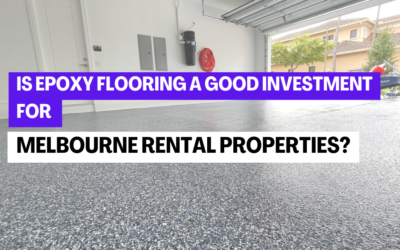Epoxy flooring has become a favorite among homeowners and DIY enthusiasts due to its remarkable durability, appealing aesthetics, and low maintenance requirements. Whether you’re looking to upgrade your garage, basement, or any other concrete surface, epoxy flooring offers a cost-effective and visually appealing solution. In Melbourne, DIY epoxy flooring projects have surged in popularity, with many residents embracing the challenge of transforming their spaces on their own. This comprehensive guide will walk you through everything you need to know about DIY epoxy flooring in Melbourne, from understanding the basics to executing a flawless finish.
1. Understanding Epoxy Flooring
Definition and Composition of Epoxy Flooring
Epoxy flooring is a type of resinous flooring system created by combining epoxy resin with a hardening agent. When these two components are mixed, a chemical reaction occurs, resulting in a rigid plastic material that bonds exceptionally well to the concrete substrate. This process forms a durable, seamless, and high-gloss floor coating that can withstand heavy traffic and harsh conditions.
Types of Epoxy Flooring
- Water-Based Epoxy: Easier to apply and clean up, water-based epoxy is less durable than other types but is ideal for residential use where heavy traffic is not a concern. It emits fewer fumes, making it safer for indoor applications.
- Solvent-Based Epoxy: Provides a tougher and more durable finish than water-based epoxy but emits strong fumes during application, requiring proper ventilation. It is suitable for areas subjected to heavier use and chemicals.
- Solid Epoxy: The most durable type, solid epoxy contains no solvents and is used in high-traffic areas. It offers excellent adhesion and resistance to chemicals and abrasions, making it ideal for industrial and commercial settings.
Advantages of Epoxy Flooring
Here are benefits of epoxy flooring:
- Durability: Epoxy floors are incredibly tough and can withstand heavy traffic and impacts, making them ideal for garages, workshops, and industrial spaces.
- Aesthetics: Available in a variety of colors and finishes, epoxy flooring can enhance the look of any space, offering options like metallic finishes, decorative flakes, and custom designs.
- Maintenance: Easy to clean and resistant to stains, spills, and chemicals. Regular sweeping and occasional mopping are usually sufficient to maintain their appearance.
- Longevity: With proper installation and care, epoxy floors can last for decades without significant wear and tear.
2. Preparing for Your DIY Epoxy Flooring Project
Assessing the Area and Planning the Project
Before starting, evaluate the condition of your concrete surface. Look for cracks, moisture issues, and other imperfections that need addressing. It’s essential to plan the project timeline, considering the curing times for each layer of epoxy. Ensure the weather conditions are suitable, as extreme temperatures and humidity can affect the application and curing process.
Tools and Materials Needed
- Epoxy Resin and Hardener: Choose the right type of epoxy for your project. Ensure you have enough material to cover the entire surface area.
- Concrete Cleaner and Etcher: Essential for preparing the surface, removing any existing stains, oils, and dirt.
- Paint Rollers, Brushes, and Mixers: For applying the epoxy evenly across the surface. A drill with a mixing attachment can help achieve a thorough mix.
- Safety Gear: Gloves, goggles, and respirators to protect yourself from fumes and chemicals. Long-sleeved clothing and knee pads can also be beneficial.
- Additional Supplies: Painter’s tape, plastic sheeting, and a measuring tape for precise application and protection of adjacent areas.
Cost Considerations and Budgeting
Budget for materials, tools, and any additional supplies. Compare prices from local suppliers and online stores to get the best deals. Consider renting tools if you don’t have them. Typical costs can range from $15 to $35 per square meter, depending on the type and quality of epoxy used.
3. Step-by-Step Guide to DIY Epoxy Flooring
Step 1: Surface Preparation
- Cleaning the Concrete Surface: Remove all dirt, oil, and debris. Use a concrete cleaner for a thorough clean. Pressure washing can help remove stubborn dirt and contaminants.
- Repairing Cracks and Imperfections: Fill cracks and holes with a suitable filler, such as epoxy crack filler or concrete patching compound, and allow them to dry completely. Sand the patched areas to ensure a smooth surface.
- Etching the Concrete: Use a concrete etcher to roughen the surface for better adhesion. This step is crucial for ensuring the epoxy bonds well with the concrete.
- Ensuring the Surface is Dry and Dust-Free: After cleaning and etching, ensure the surface is completely dry and free of dust before applying epoxy. Use a vacuum to remove any residual dust.
Step 2: Mixing the Epoxy
- Understanding the Mixing Ratios: Follow the manufacturer’s instructions for mixing resin and hardener. Incorrect ratios can result in improper curing.
- Properly Mixing the Resin and Hardener: Mix thoroughly to ensure a consistent blend. Use a drill with a mixing attachment for best results.
- Allowing the Mixture to Rest (Induction Time): Let the mixture sit for the recommended time before application. This allows the chemical reaction to begin, ensuring a better bond.
Step 3: Applying the Epoxy Coating
- Priming the Concrete (if necessary): Apply a primer if recommended by the epoxy manufacturer. This helps with adhesion and can improve the durability of the epoxy floor.
- Applying the First Coat of Epoxy: Use a roller to apply an even coat. Work in small sections to ensure even coverage. Begin from the farthest corner and work towards the exit to avoid stepping on the wet epoxy.
- Adding Decorative Flakes (optional): Sprinkle decorative flakes onto the wet epoxy for a unique look. Be sure to distribute them evenly for a consistent appearance.
- Allowing the First Coat to Cure: Let the first coat cure according to the manufacturer’s instructions, typically 24 hours.
- Applying the Second Coat: Apply the second coat of epoxy for added durability and finish. This coat should be applied similarly to the first, ensuring even coverage.
Step 4: Curing and Finishing
- Curing Times and Conditions: Allow sufficient time for the epoxy to cure fully. This can range from 24 to 72 hours, depending on the product and environmental conditions.
- Adding a Topcoat for Extra Protection: Apply a topcoat if desired for extra durability. This can add UV protection and an additional layer of toughness.
- Final Touches and Inspection: Inspect the finished floor for any missed spots or imperfections. Touch up as necessary and remove any painter’s tape and plastic sheeting.
4. Tips and Tricks for a Successful DIY Epoxy Flooring Project
- Ensuring Proper Ventilation During Application: Open windows and use fans to ventilate the area. This helps to disperse fumes and aids in curing.
- Temperature and Humidity Considerations: Apply epoxy in the recommended temperature range for best results. High humidity can interfere with curing, leading to a cloudy finish.
- Avoiding Common Mistakes: Ensure proper mixing and application to avoid issues like bubbling and uneven coating. Take your time with each step to ensure quality results.
- Maintenance Tips for Long-Lasting Epoxy Flooring: Clean spills immediately and avoid using harsh chemicals for cleaning. Use a soft-bristle broom and a mild detergent for regular maintenance.
5. Local Resources and Suppliers in Melbourne
List of Local Suppliers for Epoxy Materials
- Bunnings Warehouse: A popular hardware store with a variety of epoxy products and knowledgeable staff.
- Mitre 10: Another reliable source for DIY materials, including epoxy, with locations throughout Melbourne.
- Specialty Stores: Local shops specializing in flooring and epoxy products can offer tailored advice and higher-end materials.
Recommendations for Where to Buy Tools and Equipment
- Local Hardware Stores: Bunnings, Mitre 10, and other local hardware stores offer a wide range of tools and equipment.
- Online Retailers: Websites like eBay and Amazon for specialized tools and equipment can provide convenience and often competitive prices.
Local Workshops and Classes for DIY Enthusiasts
- Community Centers: Often offer workshops on home improvement projects, including epoxy flooring.
- DIY Stores: Some stores provide classes on epoxy flooring and other DIY projects. Check their schedules for upcoming workshops.
6. Conclusion
By following this guide, you’ll be well-equipped to tackle your DIY epoxy flooring project in Melbourne. Whether you’re upgrading your garage, basement, or any other space, epoxy flooring offers a durable, attractive, and easy-to-maintain solution that you can achieve with a bit of effort and the right tools. Good luck, and happy flooring!





0 Comments